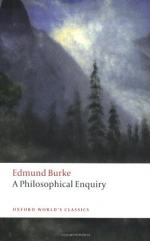
|
| Name: _________________________ | Period: ___________________ |
This test consists of 15 multiple choice questions and 5 short answer questions.
Multiple Choice Questions
1. What passage does Burke offer as an example of the effect of words?
(a) A description of the Danube river.
(b) A monologue from a dramatic production.
(c) A travel account of Syria.
(d) A satirical essay about religion.
2. What does Burke envision would be the result of fitness trumping beauty in the human species?
(a) The general intelligence quotient would rise dramatically.
(b) All people would be healthy, regardless of their looks.
(c) Individuals would find it difficult to get married and begin families.
(d) Men would be considered more beautiful than women.
3. What does Burke term "compounded abstract" words?
(a) Those words which represent complex ideas.
(b) Those words which stand for literary ideas.
(c) Those words which indicate natural phenomena.
(d) Those words which determine scientific nomenclature.
4. What does Burke consider darkness to be?
(a) The least imposing natural phenomenon.
(b) Terrible in its own nature.
(c) Something with which all people are comfortable.
(d) The highest level of the sublime.
5. Which principle fits the image of a long, bare wall, according to Burke?
(a) Vastness.
(b) Perspective.
(c) Proportion.
(d) Infinity.
6. What visual example does Burke FIRST offer in his explanation of succession and the sublime?
(a) A colonnade of pillars.
(b) A grove of trees.
(c) A large cathedral.
(d) A field of grain.
7. Which kinds of colors does Burke argue are essential to beauty?
(a) Bold, vibrant colors.
(b) Dusky, opaque colors.
(c) Strong, glaring colors.
(d) Soft, clean, fair colors.
8. Why does Burke include a section on the effect of words in "A Philosophical Enquiry Into the Origin of Our Ideas of the Sublime and Beautiful"?
(a) He believes that words affect us differently than images or objects, and wants to discuss them.
(b) He indicates that not enough literary criticism is worthwhile, and wishes to demonstrate quality writing.
(c) He desires to refute all the claims of visual artists in order to place written art on a pedestal.
(d) He includes this section as a way to generate interest in his own poetical publications.
9. What type of poetry operates by imitation?
(a) Elegiac poetry.
(b) Dramatic poetry.
(c) Lyric poetry.
(d) Epic poetry.
10. How does Burke define "association?"
(a) As a set of memories worn into the mind.
(b) As a group of words that defines another group of words.
(c) As a somewhat friendly acquaintance.
(d) As a specific group of businessmen.
11. To what does Burke tie his own opinion of darkness and the sublime?
(a) Judgment.
(b) Desire.
(c) Intellectualism.
(d) Self-preservation.
12. To what does a "clear" expression relate?
(a) To one's understanding and to reality.
(b) To one's soul and one's intellect.
(c) To one's passions and one's feelings.
(d) To one's will and one's desires.
13. Who was Campanella, and for what was he famous?
(a) He was a soldier-sailor famous for acts of bravery at a crucial battle.
(b) He was a statesman famous for brokering deals between opposing parties.
(c) He was an artist and poet famous for his depictions of ancient Greece and Rome.
(d) He was a monk famous for mimicking the facial expressions of others.
14. Which is one of the examples Burke cites to demonstrate the sublime in poetry?
(a) An elegy on the death of Milton.
(b) A description of Helen of Troy.
(c) A love poem to Aphrodite.
(d) A ballad about the battle of Culloden.
15. How does Burke define "blackness?"
(a) As "partial darkness."
(b) As "potentially dangerous."
(c) As "increased darkness."
(d) As "necessarily evil."
Short Answer Questions
1. According to Burke, what parts of the mind do beautiful things engage, and how?
2. What body part's workings does Burke describe in detail?
3. Which two effects are often combined and alternated under the passions mentioned in question 7?
4. Why does Burke use the example of Campanella?
5. What are the first examples Burke cites to demonstrate his argument about beauty and proportion?
|
This section contains 684 words (approx. 3 pages at 300 words per page) |

|




